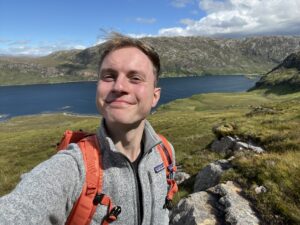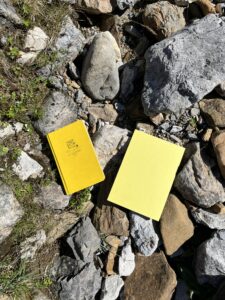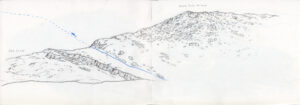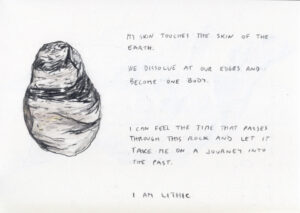Into the Zone of Complication: A c/a/r/tographic exploration of the future of Earth science education
About the author

Vojta Hybl is a nature illustrator and educator who completed the Outdoor Environmental and Sustainability Education programme in 2024. Originally from the Czech Republic, he moved to Scotland in 2019 to study geology and physical geography. He enjoys finding creative approaches to educating about nature and the environment, such as through the combination of science and art. For more information, you can contact Vojta at hello@vojtahybl.com, on Instagram (@vojta.illustrates) or BlueSky (@vojtahybl.com).
Finding and asking
I came into the Outdoor Environmental and Sustainability Education programme as a fresh geology and physical geography graduate: rocks and landscapes were my whole world. From the start, I had a feeling that they would be integral to my dissertation too, and – spoiler alert – they were.
When deciding on how to approach my dissertation, I knew that I would not go down a traditional research route. I had written a very objective and quantitative dissertation for my undergrad, so I wanted to challenge myself by approaching it from a subjective and qualitative point of view. By chance, I stumbled upon a/r/tography: an arts-based methodology that works at the intersection of one’s identities of an artist, researcher and teacher. C/a/r/tography adds an element of slow engagement with a place. It would allow me to research my practice as an illustrator and educator, and help my personal experience inform how I teach about the Earth. It would also enable me to challenge the mind/body, objective/subjective, art/science and other dichotomies that are so abundant in our society. I centred my research question around Rogers’ et al. (2024) timely investigation of the current state of Earth science and its perception by non-geologists (to sum up: it’s very poor because geologists don’t communicate it well). How can we make rocks relevant? Is there a different, gentler, more ethical way to teach geology? What possibilities for teaching does a posthuman and relational engagement with the Earth present?
I took this as an opportunity to re/visit Assynt in the Northwest Highlands to gather my data. I first came there for a geology field course during my undergrad in 2022: back then, we were taught about the rocks and landscapes. This time, I would engage with the same places through art to see how my perception of them changed. I equipped myself with a yellow sketchbook reminiscent of my geology field notebook and set out to the northwest tip of Scotland. To help me guide my fieldwork, I devised the following protocol of open-ended prompts:
- Re/visit places described in the 2022 field notebook.
- Walk-with and be guided by the place.
- Co-create with the lithosphere, atmosphere, hydrosphere and biosphere.
- Map movement.
- Slow down and think-with any concepts that emerge during the process.
 My 2022 field notebook (left) and 2024 sketchbook (right)
My 2022 field notebook (left) and 2024 sketchbook (right)
Gathering
Re/engaging (in the sense of both engaging again and engaging in a new way as if for the first time) with the landscape was more difficult than I had anticipated. I was unable to forget what I had been taught. The only way was to unlearn in order to learn again. I couldn’t merely write about the local rocks in order to answer my research question, but write with and through them. I needed to become lithic myself. Over several days, I hiked, sketched and wrote about my experience with the rocks, plants, animals, fungi and landforms. The 78 pages of my sketchbook were filled with drawings, paintings and the thoughts they provoked.

I engaged with the geological processes that shaped Assynt in order to guide my thinking. The Glencoul thrust fault acted as a metaphor for the restructuring of my thoughts.
When I returned, I compared my 2024 notes with the 2022 field observations: I noted their differences and similarities, and thought-with the concepts that emerged. In my approach to working with my data I utilised rhizoanalysis: intertwining and interlayering the science and the art instead of pitting them against each other. Numbers and measurements lay comfortably next to personal reflections. They were mapped onto a review and critique of the history of Earth science, geology of Assynt, deep time thinking, timefulness and the concept of the Anthropocene. This allowed me to question what I had been taught (in both my undergraduate and postgraduate degrees) and move freely between being an artist, a scientist, a researcher and a teacher.
Challenging
A feature of a/r/tographic research is that it does not always need a conclusion: the process is more important than the outcome. However, I knew that I needed to have some sort of a culmination for myself. The aim was for all this theoretical thinking to inform my educational practice (and vice versa). Based on my readings and personal experiences in Assynt, I came up with a set of tentative touchstones (pun not intended) that present a different way to teach about rocks:
- Be-with rocks: find a way of engagement which resonates with your interests and those of your learners; it does not need to be through science only.
- Make-with rocks: acknowledge that rocks are the co-authors of any educational experience which concerns them.
- Teach-with rocks: let the stories and features of rocks inform how you educate about them; use the affordances of the place.
- Move-with rocks: both mentally and physically; pay attention to the slow and the fast; let rock features guide you.
- Become lithic: embrace other ways of knowing; experiment with your mind and body to relate to rocks; use all senses.
Through my ‘lithic praxis’, I want to challenge the way Earth science is taught today with its innate extractivism and lack of more-than-human thinking. Instead of teaching about rocks, it teaches with and through them.

Becoming lithic
I conclude with some of the most influential readings that helped inform how I approached my dissertation:
References
Adam, R., Whitehouse, H., Stevenson, R. B., & Chigeza, P. (2020). The Socioecological (Un)learner: Unlearning Binary Oppositions and the Wicked Problems of the Anthropocene. In A. Cutter-Mackenzie-Knowles, A. Lasczik, J. Wilks, M. Logan, A. Turner, & W. Boyd (Eds.), Touchstones for Deterritorializing Socioecological Learning: The Anthropocene, Posthumanism and Common Worlds as Creative Milieux (pp. 49–74). Springer International Publishing. https://doi.org/10.1007/978-3-030-12212-6_3.
Allen, R. (2024). Weathering: How the Earth’s deep wisdom can help endure life’s storms (1st ed.). Ebury Press.
Bjornerud, M. (2018). Timefulness: How Thinking Like a Geologist Can Help Save the World (1st ed.). Princeton University Press.
Irwin, R. L., Beer, R., Springgay, S., Grauer, K., Xiong, G., & Bickel, B. (2006). The Rhizomatic Relations of A/r/tography. Studies in Art Education, 48(1), 70–88. https://doi.org/10.1080/00393541.2006.11650500.
Johnstone, S. (2022). Red Lake Breccia: Arts-Integration to Map a Fractured Relationship with Geoscientific Knowledge Production Networks. Art/Research International: A Transdisciplinary Journal, 7(1), Article 1. https://doi.org/10.18432/ari29630.
Lasczik, A., Rousell, D., Irwin, R. L., Cutter-Mackenzie-Knowles, A., & Lee, N. (2021). Walking with A/r/tography: An Orientation. In A. Lasczik, R. L. Irwin, A. Cutter-Mackenzie-Knowles, D. Rousell, & N. Lee (Eds.), Walking with A/r/tography (pp. 1–16). Springer International Publishing. https://doi.org/10.1007/978-3-030-88612-7.
Lasczik Cutcher, A., & Irwin, R. L. (2017). Walkings-through paint: A c/a/r/tography of slow scholarship. Journal of Curriculum and Pedagogy, 14(2), 116–124. https://doi.org/10.1080/15505170.2017.1310680.
Rogers, S. L., Giles, S., Dowey, N., Greene, S. E., Bhatia, R., Van Landeghem, K., & King, C. (2024). “you just look at rocks, and have beards” Perceptions of Geology From the United Kingdom: A Qualitative Analysis From an Online Survey. Earth Science, Systems and Society, 4, 10078. https://doi.org/10.3389/esss.2024.10078.
Rogers, S. L., Lau, L., Dowey, N., Sheikh, H., & Williams, R. (2022). Geology uprooted! Decolonising the curriculum for geologists. Geoscience Communication, 5(3), 189–189.
Springgay, S., Irwin, R. L., & Wilson Kind, S. (2005). A/r/tography as Living Inquiry Through Art and Text. Qualitative Inquiry, 11(6), 897–912. https://doi.org/10.1177/1077800405280696.
Van Horn, G., Kimmerer, R. W. & Hausdoerffer, J. (Eds.), Kinship: Belonging in a World of Relations: Vol. 1: Planet (1st ed., pp. 1–11). Center for Humans & Nature.
Young, T., & Cutter-Mackenzie-Knowles, A. (2020). Posthumanist Learning: Nature as Event. In A. Cutter-Mackenzie-Knowles, A. Lasczik, J. Wilks, M. Logan, A. Turner, & W. Boyd (Eds.), Touchstones for Deterritorializing Socioecological Learning: The Anthropocene, Posthumanism and Common Worlds as Creative Milieux (pp. 27–48). Springer International Publishing. https://doi.org/10.1007/978-3-030-12212-6_2.




Comments are closed
Comments to this thread have been closed by the post author or by an administrator.